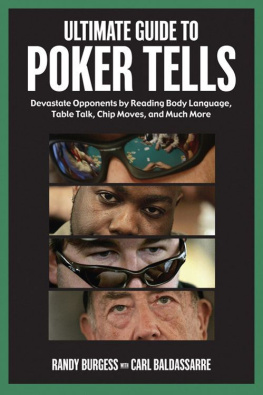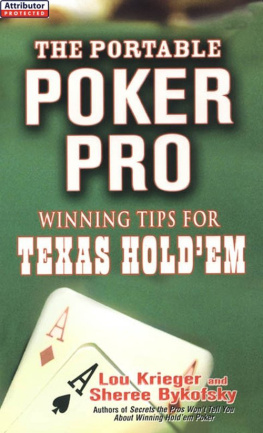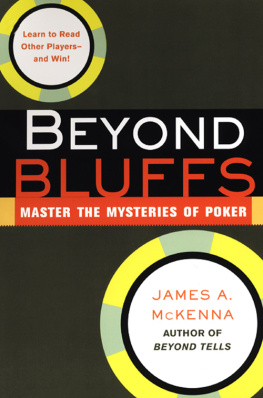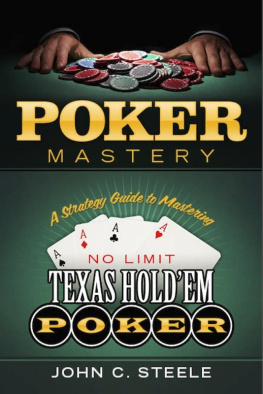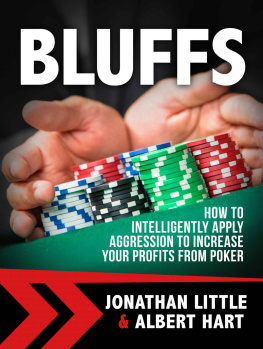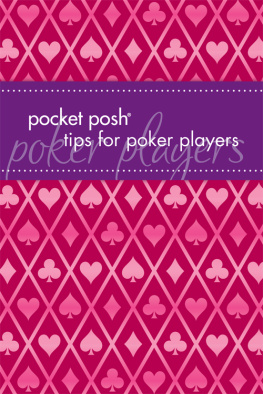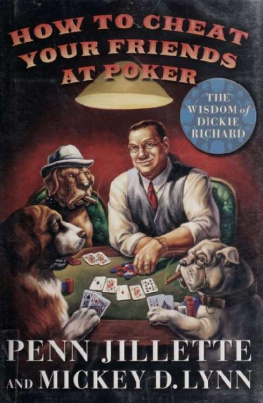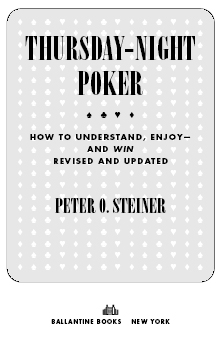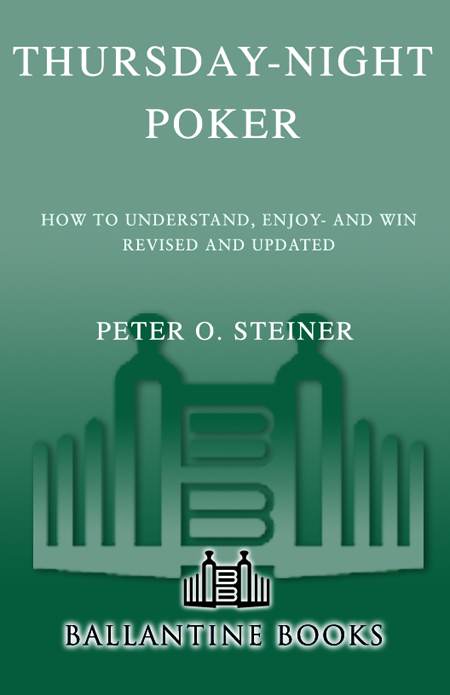
Contents






TO JAMES V. MCCONNELL, psychologist, poker player, friend. He was extraordinary in each role. Jim started me on the project that became this book, and would have been its co-author if he were still alive.
Authors Note

When I started writing Thursday-Night Poker ten years ago, it was sensible to think of at least three, largely distinct, kinds of poker games that were played regularly:
1. small-stakes, dealers-choice, home poker games, played around the kitchen table, where a large variety of high-low games, and often wild-card games, were played regularly with family, friends, or groups of colleagues;
2. serious poker, played at home or in clubs, on a regular basis, for moderate but not trivial stakeswhat I labeled Thursday-night poker;
3. poker played in casinos by a mixture of poker professionals, high rollers, and passing-through tourists.
My book was aimed at the second group. I pictured it as a game of seven or eight players in their homes or clubs under either of two kinds of betting rules: first, a fixed-limit game where the maximum bet allowed is $5 or $10 or perhaps as much as $20; second, a low-ante, pot-limit game where no bet can ever exceed the size of the pot at the time it is made, and also where the maximum bet is limited to either $50 or $100. In either of these types of games a players winnings or losings in a five-hour session will range typically from $50 to a few hundred dollars, and virtually never be as much as $1,000. My specific focus, then, is not nickel-dime poker nor high-stakes poker, nor poker as played in the gambling casinos of the world.
I believed then, and still do, that there was insight in my exposition that would be useful to players of lower- and higher-stakes games, but that the particular strategies would have to be adapted to different conditions.
By the publication of this revised edition in 2005, much of that clear distinction between the second and third types has been greatly eroded. This is due both to the widespread and immensely popular television coverage of big poker tournaments, and to the availability and spread of Internet poker, where one can play either ring games or tournaments for real money against real opponents for stakes from trivial to huge. Both in the games played and the styles of play, casino and tournament poker have invaded Thursday-night poker and, to some extent, changed the playing habits of home players. Players who had never heard of Texas Holdem (Holdem) or Omaha Hi-Lo, 8-or-better, now play them avidly, and even knowledgeably at home, but also on the Internet and in the enormously increased number of legal poker rooms in the burgeoning numbers of casinos around the country. And there has been a great surge of new players who didnt learn the game around the kitchen table; they now swell the attendance at casinos and have spawned a major industry of Internet poker sites.
This revision, while still aimed at the old-line Thursday-night player, now recognizes that he or she will be likely to be playing on the Internet as well, and may occasionally spend time in a casino poker room. I also hope it will speak to the newer generation of amateur poker players. What it does not try to do is discuss how to become a poker-playing professional, though there is some attention paid to surviving in games where a professional may be present.
PLAN OF THE BOOK
Poker games differ from one another in important ways. While all have features in common, the differences become crucial in discussing strategy and tactics. Part I provides a survey of the varieties of games and players, and shows how particular games serve different objectives. Part II explains the basic principles that every serious poker player will want to understand, and suggests ways that they can be employed. Part III deals with the skills that distinguish good from mediocre players, skills that are needed in every variety of game and at every level of stakes.
Part IV applies these principles and skills to each of seven different varieties of poker games. Because high-low games play such a prominent role in home poker, some substantial attention is given to the differences in play that are required in high-only and high-low poker. While in most home poker games dealers choice is the rule, and thus there is enormous variety in the specific games played, a relatively small number of varieties of game is sufficient to illustrate all the principles of sound play, and I will limit attention to them. These are the old standbys of draw poker, 5-card stud, and 7-card stud, both high-only and high-low, and the now increasingly popular casino staples of Texas Holdem, Omaha, and Omaha Hi-Lo, 8-or-better.
These chapters suggest the specific tactics and strategies that are appropriate for the opening rounds of betting, which is where the biggest differences among games occur. Starting strategies depend upon the game chosen, the stakes, and the nature of the opposition. These chapters are necessarily longer than the earlier, more general chapters, and each has in it exercises to permit the reader to test and hone his skills. While each of the applied chapters assumes that the reader has already read Parts II and III of the book, they are largely independent of one another.
Finally, Part V recognizes an expanded poker world that today attracts the Thursday-night poker player. Attention is given to both casino and Internet play, and to both ring-game and tournament play, and how the fundamentals of sound play in each of these differs from that of the home game. I have also retained in this part a chapter on cheating and how to be wary of it, since, alas, it is not merely a relic of the past.
Because poker players typically employ and relish an extensive jargon that often makes the less experienced amateur feel he is in a foreign land, I have provided a Glossary in the back of this book to allay any such insecurities. A short, select, and briefly annotated list of books about poker that I have enjoyed and/or found useful also appears at the end.
P.O.S.
Acknowledgments for the Revised Edition

I owe special thanks to two Random House editors, without whom this book would not exist. The first is the late Joe Fox, who nine years ago saw merit in my manuscript and persuaded Random House to publish it. He had the bad grace to die on the eve of its publication, and continues to be remembered and missed by a legion of authors and friends. The second is Judy Sternlight, who encouraged me to do this revision and has been a gentle and helpful guide at every step.
Next page

